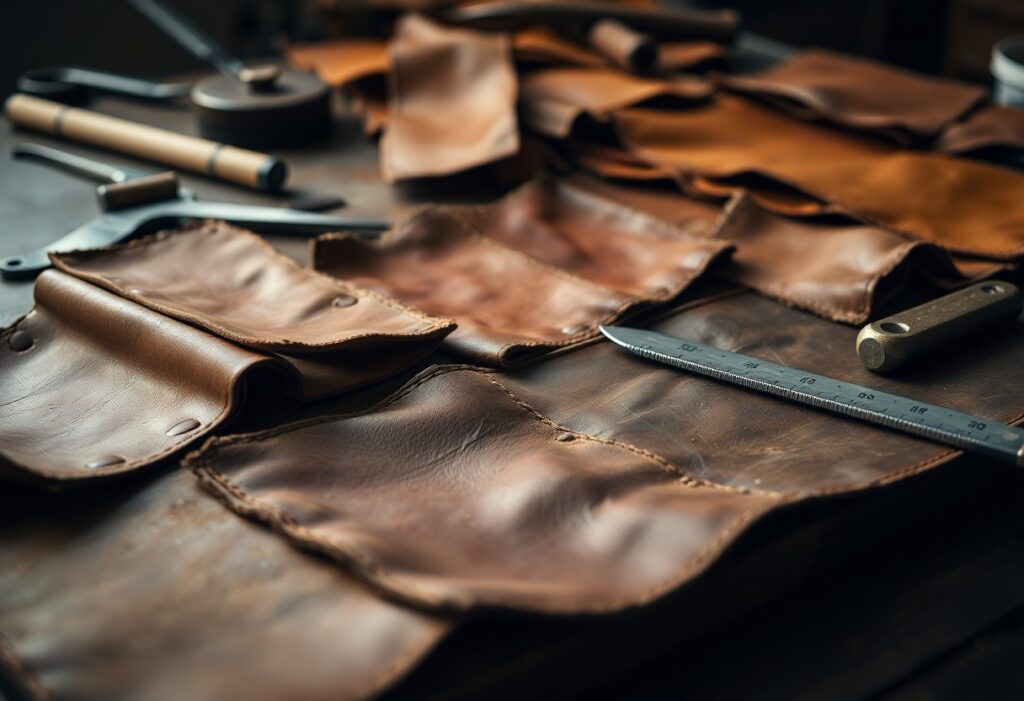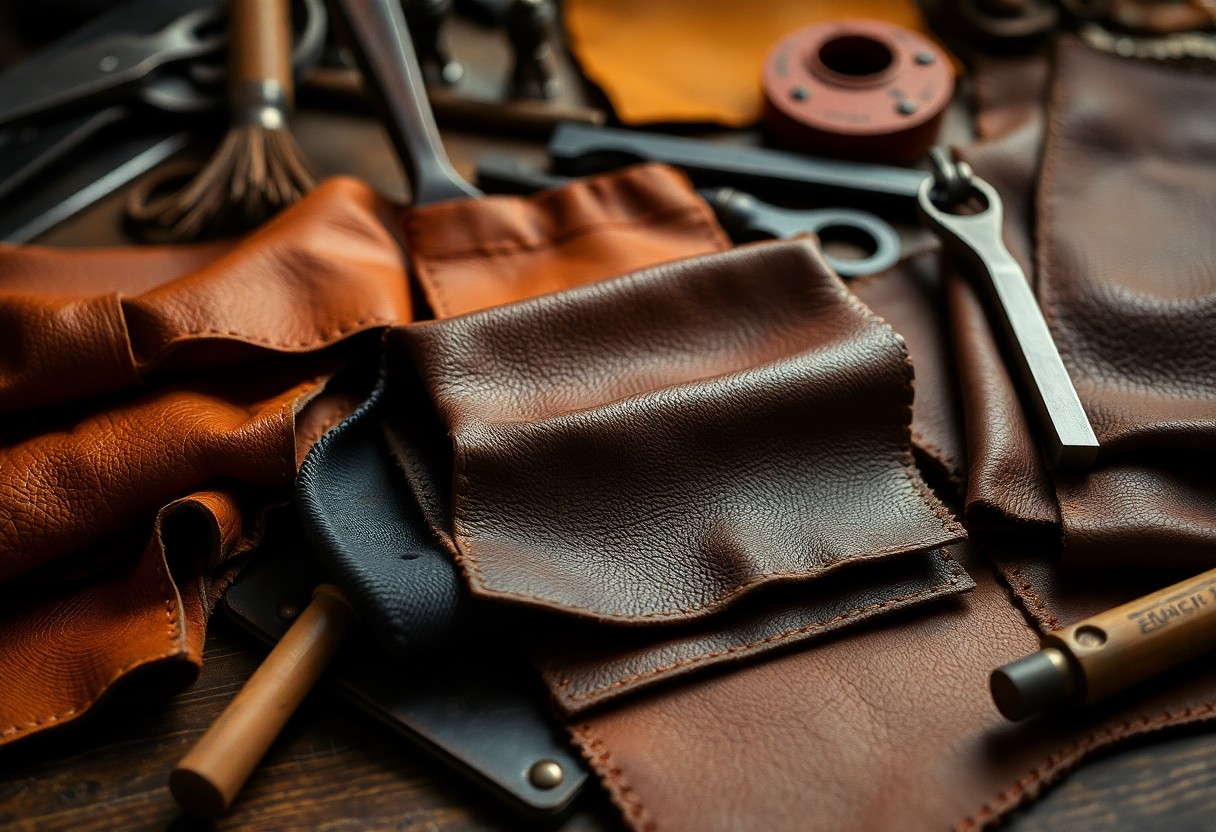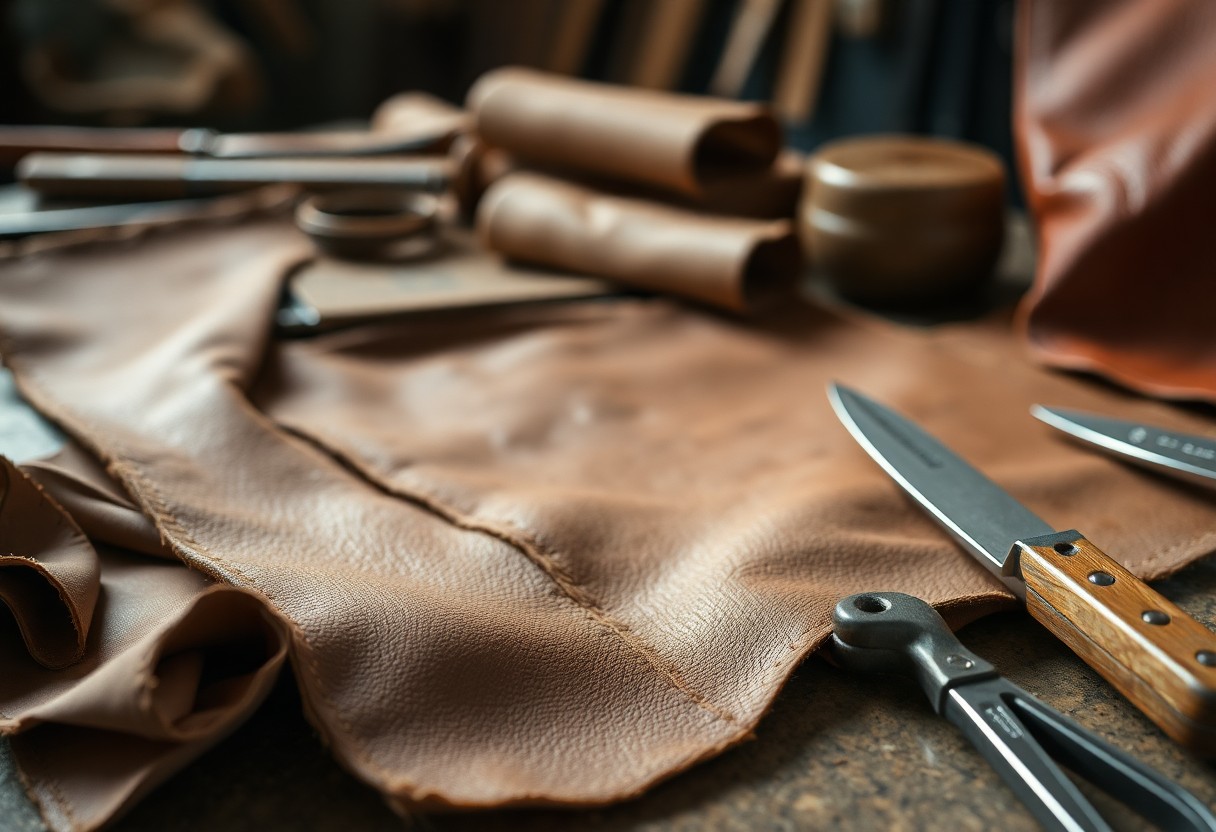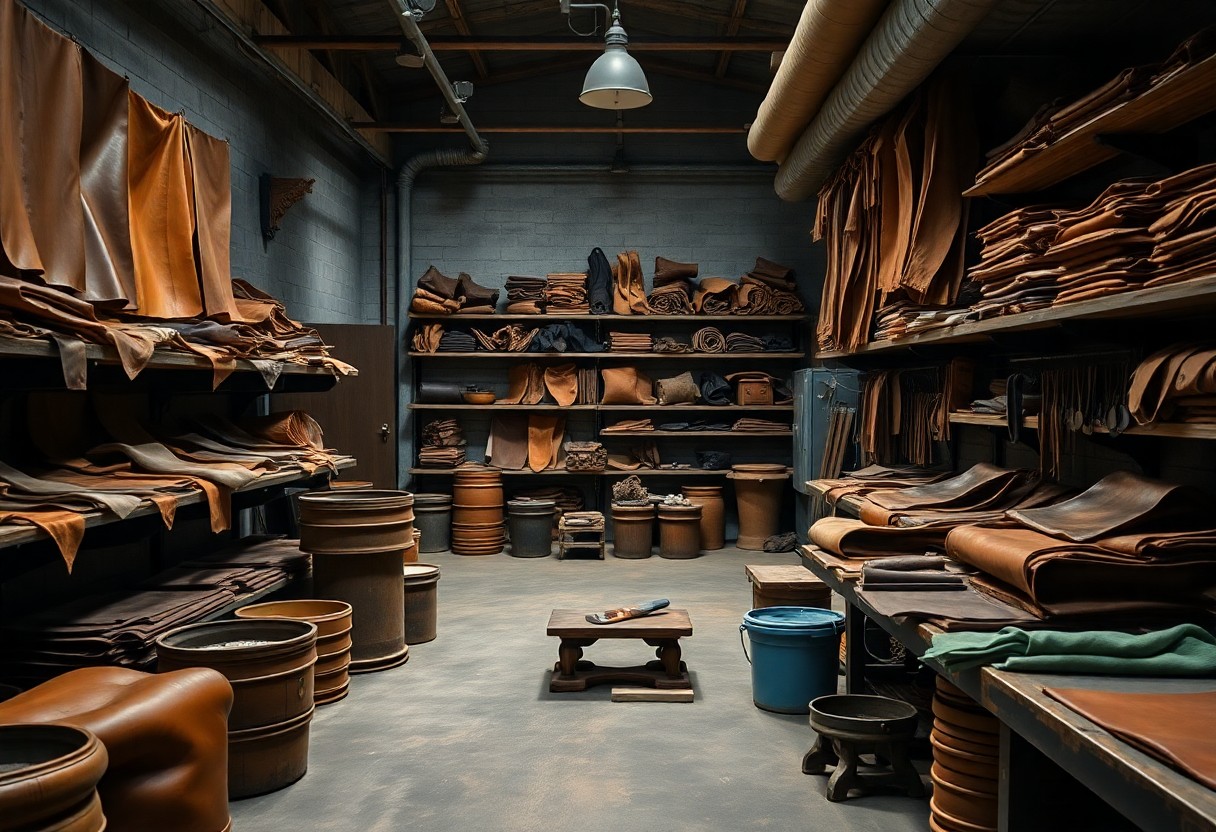
The evolution of leather tanning has developed into a complex process that significantly influences the quality and longevity of your leather goods. Each tanning method, including chrome tanning, vegetable tanning, and chrome-free techniques, produces leather with unique characteristics that greatly affect its durability, water resistance, tactile appeal, and color retention as time progresses. The tanning journey commences with raw hides and advances through several essential stages, each crucial in determining the leather’s final qualities. By understanding these processes, you can make educated choices about leather quality while considering the environmental implications, as some methods are considerably more sustainable than others.
Explore the Various Leather Tanning Techniques Available
The production of leather utilizes diverse tanning methods to transform raw hides into functional leather. The most prevalent techniques encompass chrome tanning, vegetable tanning, and chrome-free tanning. This comprehensive guide is designed to enhance your knowledge of the intricacies involved in each method, equipping you with the insights needed to select the technique that best aligns with your leather needs and personal preferences.
| Method | Characteristics |
| Chrome Tanning | Fast processing, water-resistant, dominates global production (85%) |
| Vegetable Tanning | Natural, eco-friendly, lower production share (10%) |
| Chrome-free Tanning | Environmentally safe, constitutes 5% of production |
| Combination Tanning | Combines multiple methods for distinct leather properties |
| Aldehyde Tanning | Specialized for specific applications |
Understand the Benefits of Chrome Tanning Techniques
The chrome tanning method employs chromium (III) salts to produce leather that is soft, supple, and highly desirable for a diverse range of applications. This approach not only results in leather that is water-resistant but also facilitates easy dye absorption, making it a preferred choice across the leather industry. The impressive efficiency of chrome tanning typically allows the process to be completed within 24 to 48 hours, making it particularly advantageous for manufacturers with mass production needs.
Discover the Timeless Craft of Vegetable Tanning
As one of the oldest and most esteemed methods, vegetable tanning utilizes natural tannins sourced from tree bark and foliage. This technique is celebrated for yielding leather that develops a rich patina over time, aging gracefully while remaining biodegradable. Different types of vegetable tanning, which use extracts from sources such as oak bark, chestnut, and mimosa, contribute to the unique characteristics of the finished product. However, this labor-intensive process generally requires around 4 to 6 weeks, resulting in leather that is often firmer and more structured compared to its chrome-tanned counterparts.

In-Depth Breakdown of the Leather Tanning Process
Transforming raw hides into high-quality leather involves a systematic and organized workflow. Below, we provide a detailed overview of each key step and its significance in achieving the desired attributes of the leather.
Essential Preparatory Steps for High-Quality Leather
To achieve the best quality leather, raw hides must undergo a series of meticulous preparation processes. The initial phase involves soaking the hides in clean water for 24 to 48 hours to eliminate salt and impurities, followed by a liming process that effectively removes hair and fat. Maintaining precise pH control during this stage is crucial to prevent any potential damage to the hides and ensure the most favorable outcome.
Core Tanning Phase: Key Processes You Should Know
The pretanning stage initiates with deliming and pickling, preparing the hides for the primary tanning agents. The most widely utilized method, chrome tanning, incorporates chromium sulfate, enabling leather production in as little as 24 hours. In contrast, vegetable tanning depends on natural tannins, extending the process to approximately 20 to 60 days.
Temperature regulation is another critical aspect of the tanning process. Chrome tanning typically takes place at temperatures ranging from 35 to 40°C, whereas vegetable tanning is conducted at cooler temperatures of 20 to 25°C. Continuous pH monitoring is essential to prevent damage to the leather and ensure optimal absorption of the tanning agents.
Advanced Leather Treatment Techniques for Enhanced Quality
A variety of techniques are employed to enhance the properties of your leather. From surface finishing to deep penetration treatments, each method serves a specific purpose. Proper leather treatment can extend the lifespan of your leather by up to 50% and significantly improve its resistance to water, heat, and wear.
Examining Diverse Surface Treatments for Leather
Surface treatments applied to leather may include waxing, buffing, and protective coatings. These procedures can enhance water resistance by up to 70% and provide the option of a glossy or matte finish based on your aesthetic preferences. Additionally, surface treatments play a vital role in protecting leather against UV damage and the wear and tear associated with daily use.
Understanding Dyeing Techniques for Enhanced Color and Durability
Your leather can absorb various types of dyes at different depths. Aniline dyeing, for instance, penetrates deeply into the leather, while surface dyeing allows for a more controlled application of color. The dyeing method you select will have a direct impact on both the aesthetic and longevity of the leather.
Moreover, the dyeing technique you choose significantly influences the final characteristics of the leather. Drum dyeing can achieve up to 95% color penetration, while spray dyeing offers enhanced precision in color application. It’s important to note that natural dyes are more eco-friendly but may fade approximately 20% faster than synthetic alternatives.

Identifying the Critical Quality Factors in Leather Processing
The quality of leather is shaped by numerous interconnected factors throughout the processing chain. Recognizing these elements is vital for achieving superior results in both leather selection and ongoing care. Key factors include the tanning method, hide quality, and processing parameters, all of which play pivotal roles in determining the final properties of the leather. By mastering these aspects, you can evaluate leather quality more effectively according to your specific needs.
Selecting Raw Materials for Optimal Leather Quality
When choosing raw materials, it is crucial to prioritize the condition of the hides and the animal source. The quality of your raw materials directly influences the properties of the finished leather. The best hides come from healthy animals and feature minimal surface defects. Look for consistent thickness and the absence of parasitic damage. It is essential to select materials based on their intended end-use, as different applications require specific hide characteristics.
The Importance of Processing Parameters in Quality Assurance
There is a strong correlation between processing controls and the overall quality of leather. Maintaining strict oversight of pH levels, temperature, and chemical concentrations is crucial. Typically, the tanning duration lasts between 24 to 48 hours, with temperature controls maintained between 35 and 40°C. Your careful attention to these parameters ensures a consistent quality of leather across the entire process.
This meticulous approach should extend to every stage of processing. Monitoring moisture content (ideally kept at 45-55%), regulating drum speed during tanning, and ensuring precise chemical dosing are all critical factors. Additionally, managing drying conditions is essential to avoid any damage to the leather. A thorough focus on these parameters ultimately results in higher-quality finished leather.
Expert Recommendations for Achieving Optimal Leather Treatment Results
Not all leather treatment processes yield the same level of quality. It’s essential to emphasize temperature control, chemical balance, and timing precision throughout the tanning process to achieve the best results possible.
- Regularly check and adjust pH levels
- Maintain consistent temperatures
- Adhere to precise chemical ratios
- Document each step of the process
Recognizing the signs of effective tanning can significantly help you achieve high-quality finished leather consistently.
Strategies for Optimizing the Leather Tanning Process
To achieve optimal outcomes, it is vital to manage your tanning environment efficiently. Maintain your workspace at temperatures ranging from 20 to 25°C and keep humidity levels between 45-55%. Ensure that your chemical solutions are fresh and accurately measured. Regular equipment maintenance is essential for ensuring consistent results.
Maintaining Quality Standards in Leather Care Practices
The quality of leather is heavily influenced by your storage conditions and handling practices. Store your leather in a dry, cool environment away from direct sunlight to preserve its integrity. Regularly monitor moisture content and rotate your stock every 30 days to prevent deterioration.
Monitoring every stage of the process is critical for maintaining quality standards. Your routine checks should encompass pH testing, physical inspections, and moisture content analysis. Keeping a comprehensive record of all findings and adjusting your procedures based on these results will allow you to identify potential issues before they negatively impact your final product. Consistent quality control practices will help ensure that your leather remains in excellent condition.

Evaluating the Pros and Cons of Various Tanning Methods
To gain a comprehensive understanding of leather tanning, it is essential to evaluate different methods based on their respective advantages and disadvantages. Below is a detailed comparison of the primary tanning techniques:
| Advantages | Disadvantages |
|---|---|
| Chrome tanning: Fast processing, cost-effective | Chrome tanning: Environmental concerns, potential disposal challenges |
| Vegetable tanning: Eco-friendly, naturally sourced | Vegetable tanning: Lengthy process, higher water consumption |
| Chrome-free tanning: Environmentally safe, maintains good quality | Chrome-free tanning: More complex process, higher costs |
| Combination tanning: Offers versatile properties | Combination tanning: Difficult quality control |
Financial Implications of Leather Tanning Choices
Choosing a leather tanning method can have a profound impact on your production costs. Chrome tanning boasts 85% cost efficiency in comparison to vegetable tanning, while chrome-free techniques typically increase expenses by 20-30%.
Impact of Tanning Choices on Leather Quality
The quality of even the finest leather can be negatively affected by poor tanning decisions. The method you choose for tanning directly influences characteristics such as durability, water resistance, and overall texture.
For instance, leather treated with chrome tanning demonstrates superior water resistance and flexibility, while leather tanned using vegetable methods exhibits better aging properties and develops a distinct patina as it matures.
Essential Insights on Leather Tanning and Treatment Practices
The insights shared reveal that different leather tanning and treatment methods significantly impact the quality and characteristics of your leather. The choice between chrome, chrome-free, or vegetable tanning will greatly influence your leather’s durability, texture, and environmental implications. Additionally, the dyeing technique you select—whether aniline or crust—will dictate the depth of color and how the leather ages. Lastly, the type of finishing applied—such as full grain, corrected grain, or top-coated—determines the standards for appearance, breathability, and maintenance requirements. A comprehensive understanding of these processes empowers you to make well-informed decisions regarding your leather purchases and care strategies.
Your Questions Answered: Common Queries About Leather Tanning
Q: What are the fundamental differences between chrome tanning and vegetable tanning?
A: Chrome tanning utilizes chromium salts to produce soft, water-resistant leather that is processed quickly and economically, accounting for 85% of global leather production. In contrast, vegetable tanning employs natural tannins from tree bark and leaves, resulting in a slower processing time while yielding leather that gains character over time. Although vegetable-tanned leather is more environmentally friendly regarding disposal, it tends to be more vulnerable to staining compared to chrome-tanned options.
Q: How does aniline dyeing impact leather quality and aesthetics?
A: Aniline dyeing involves immersing leather in dye baths that penetrate deeply into the material, resulting in a uniform color throughout. This technique offers excellent color retention. Contemporary aniline-dyed leather is often partially dyed, which maintains a lighter middle layer, enhancing the leather’s stability while ensuring rich color depth on the surface.
Q: What are the differences between full grain leather and corrected grain leather?
A: Full grain leather retains its natural surface without any sanding or artificial overlays, showcasing natural pores and the strongest fiber structure, along with the ability to be restored when scuffed. In contrast, corrected grain leather is sanded and coated with a plastic layer. While corrected grain leather is easier to clean and maintain, it generally lacks breathability and may crack over time without options for repair.
The Article Guide to leather tanning and treatment methods processes types and their impact on quality appeared first on My Shoes Finder
The Article Leather Tanning: Methods, Processes, and Quality Impact Guide Was Found On https://limitsofstrategy.com






It’s fascinating to see how the nuances of leather tanning can play such a pivotal role in the end product. I’ve always been drawn to the craftsmanship behind leather goods and often find myself wondering about the stories each piece carries, starting from the raw hide to its final form.
I completely understand where you’re coming from; the world of leather tanning is indeed a blend of art and science, isn’t it? Each piece of leather tells a distinct story, from the type of animal it comes from to the specific tanning methods used. For instance, vegetable tanning, which relies on natural tannins, not only contributes to the texture and durability of leather but also gives it a unique patina over time. It makes me think about how materials evolve, almost like a living thing.
You’re spot on about leather having its own narrative; it’s fascinating how deeply rooted it is in culture and history. The way vegetable tanning not only preserves but also enriches the leather’s character over time is such an interesting metaphor for how we all change and evolve through our experiences.
You’ve captured the essence of leather tanning beautifully. It really is like following the life journey of a piece of material. Each method leaves its mark—vegetable tanning, for instance, doesn’t just take a leaf out of nature’s book; it practically co-authors it. The transformation that happens over time is something special, isn’t it? Those subtle changes in color and texture can feel like a badge of honor rather than just wear and tear.
You’ve hit the nail on the head with the mix of art and science in leather tanning. It’s fascinating how each hide carries its own history, right down to the way it’s processed. Vegetable tanning is such a cool process; the natural tannins really do give that leather its character over time. I’ve always found it remarkable how leather changes and ages—like you said, it tells its story through those subtle shifts in color and texture.
You’ve captured the essence of leather tanning beautifully. It really is fascinating how every piece has its own narrative woven into it. I find it especially interesting how the choice of tanning method influences not just the aesthetics but also the feel and longevity. With vegetable tanning, you’re right about that wonderful patina that develops over time; it’s like the leather is having its own journey, adapting and changing with age.
The story behind each leather piece truly is something special. From the raw hide to the intricate techniques used in tanning, every step contributes to the character and beauty of the final product. It’s not just craftsmanship, but a blend of history and skill passed down through generations.
It’s fascinating to see how the evolution of leather tanning intertwines with both craftsmanship and sustainability. I’ve always appreciated leather goods not just for their aesthetics but also for their story, which starts long before they reach the consumer. I remember visiting a traditional leather workshop that utilized vegetable tanning, and the rich, earthy smell of the natural materials was captivating. It made me realize how choosing leather isn’t just about fashion; it’s about supporting processes that respect the environment and history.
It’s fascinating how much thought goes into the tanning process, and it’s surprising how many people don’t realize the impact it has on both the quality of leather and the environment. I’ve always been drawn to vegetable-tanned leather because of its natural feel and the way it develops a beautiful patina over time. It feels like a living material that tells a story.
It’s fascinating to delve into the intricacies of leather tanning, especially from a sustainability perspective. As you pointed out, the choice of tanning method can significantly influence the environmental footprint of leather production. For instance, while chrome tanning is commonly favored for its efficiency and speed, it’s important to consider the chemical pollutants involved, which can have detrimental effects on local ecosystems.
Your observations on leather tanning really highlight a critical conversation around sustainability. It’s so true that the methods we choose—like chrome tanning—while efficient, often come with hidden costs to our environment. I find it interesting how much we often overlook the broader implications of our choices in daily life, like the materials we use and the processes behind them.